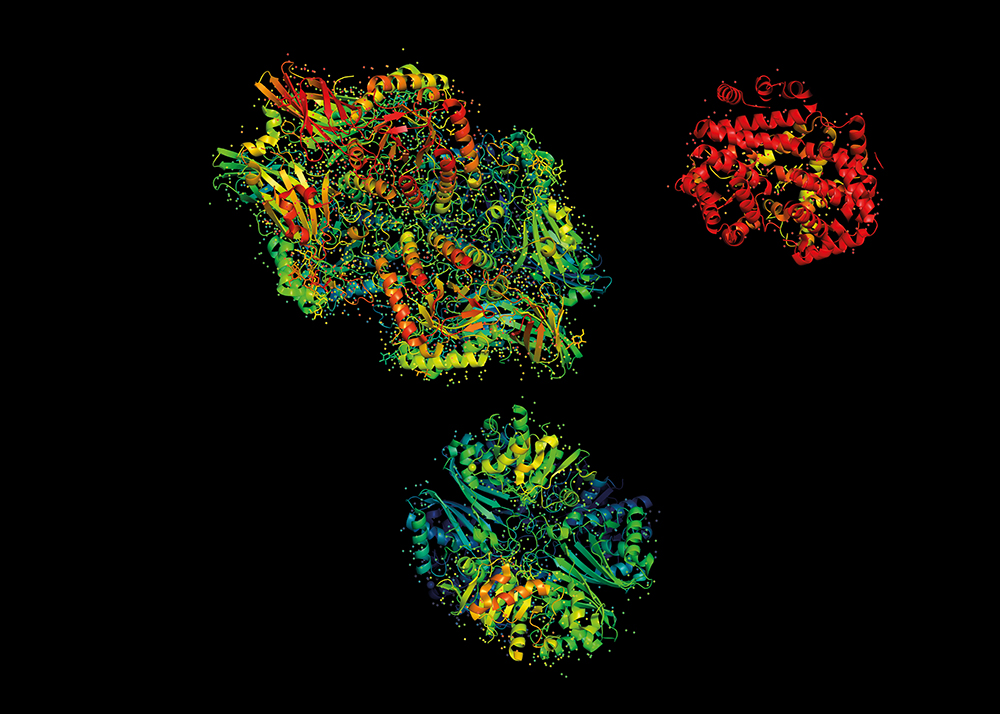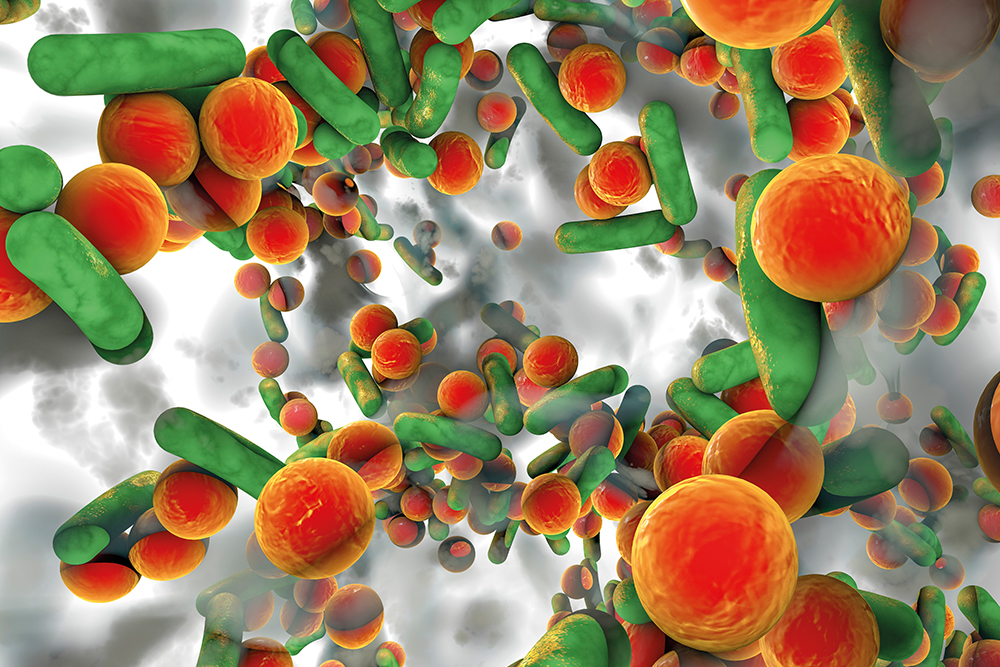Dr Zachary Senwo – Catalysing Agriculture with Enzymes
Enzymes make life as we know it possible. These active proteins are vital in nutrient cycling, metabolism, and cell functioning. With their diverse range of functions and ubiquity, enzymes could offer techniques to support healthy agricultural ecosystems, and as such, improve sustainability and future food security. Understanding their activities is vital to the organic agriculture revolution. Dr Zachary Senwo and his team at Alabama Agricultural and Mechanical (A&M) University have contributed years of important research to uncover the potential of enzymes towards informing novel agricultural practices.
Nature’s Tiny Machines
We are probably all familiar with enzymes from our school textbooks – the hard-working proteins that have fundamental roles in numerous biochemical functions, such as digestion and cell signalling. Enzymes ‘catalyse’ – or speed up – biochemical reactions that would otherwise occur millions of times slower. Without them, life on Earth would be impossible.
These tiny biochemical machines are predominantly involved in breaking down or building molecules. Some enzymes help to break down complex carbohydrates into simple sugars such as glucose, which is an important source of energy for microbes, plant, and animal cells. Others cleave mineral compounds into smaller molecules that have much increased bioavailability. With potentially hundreds of thousands of individual enzymes catalysing over 5000 different biochemical reactions, enzymes present vast, untapped potentials for solving some of our most pressing environmental and agricultural issues.
Intensive agricultural practices have wrought immense damages on the environment, the effects of which are becoming harder to ignore. Chemical fertilisers and pesticides leach from soils to disrupt aquatic ecosystems and destroy beneficial communities of soil microbes that maintain soil quality and health. A damaged ecosystem can no longer provide such important ecosystem services, as drought resilience, clean water, photosynthesis, air purification, and natural or biological pest control. Farmers are struggling to maintain high quality and high yields with the growing pressures from climate change, emerging plant diseases, and soil degradation. Without a revolutionary change in agricultural practices, the future food security of our growing human population will be severely at risk.
Working with the surrounding ecosystem instead of against it could help restore environmental health while ensuring that food demands are met. Enzymes – produced by soil microbes and plants, and through commercially available soil additives – could be a key tool in this endeavour. However, there is still much to learn about enzymes and their actions. Before farmers can adopt new practices that take advantage of the power of enzymes, they need reliable information based on robust evidence.
Dr Zachary Senwo and his team of researchers from the Department of Biological and Environmental Sciences at Alabama A&M University have devoted years of research to uncovering some of the mysteries of enzymes. Their important work investigating the mechanisms, activities, specificities, and potential applications of enzymes could help to inform new agricultural practices that not only maintain, but also restore the health of agricultural ecosystems.

Investigating Enzyme Activities
Investigating the activities of enzymes is a complex process. Experiments typically measure the amount of ‘substrate’ – the compound that the enzyme acts upon – converted to the product for a set time and amount of enzyme. However, this is just the first of many factors that scientists must consider when investigating enzyme activities, especially in soils.
Enzymes, being proteins, are sensitive to their surrounding environment. If temperatures are too low, their activities slow and eventually halt completely. If the temperature is too high, their structures quickly unravel, rendering them useless. Similarly, enzymes have functional ranges for other conditions, such as pH, outside of which they cease to function. The presence of some minerals and inhibitory molecules can also affect their efficiencies. To fully understand the potentials of various enzymes, scientists must first examine how the enzymes function under various conditions.
A better understanding of the optimal conditions for individual enzymes could aid especially limited resource farmers or agricultural producers wanting to use them for improving soil health and plant productivity. For example, enzymes functioning optimally in alkaline conditions would make a poor choice as an additive for acidic soils, and vice versa. Additionally, farmers wanting to promote the activities of enzymes produced by soil microbes may be able to tune their soils to achieve optimal conditions by using natural soil amendments.
In addition to investigating individual enzymes important in soil nutrient cycling and transformations, Dr Senwo and his team have also been developing protocols for measuring activities of different types of enzymes in organic and conventional agricultural systems. One such development was for the enzyme maltase, which is important for the conversion of the complex sugar maltose into the simple sugar glucose, so that it can be used as a source of energy by beneficial soil microbes.
Previous testing protocols had relied upon the use of artificial substrates, and as such had limited use in agricultural systems. ‘With the promotion of organic and sustainable agriculture systems and the use of poultry litter as soil amendments, which results in the addition of maltose into the soil system, it is worth developing alternative assay protocols for determining maltase activity using a natural substrate – maltose and measurement of its natural product – glucose,’ says Dr Senwo.

Supporting Sustainable Agriculture
Plants have an abundance of carbon available to them, as they sequester it from carbon dioxide in the atmosphere, but other substances are more difficult for them to obtain. For example, the availability of nitrogen and phosphorous is often a limiting factor for plant productivity because, unlike carbon, most plants cannot create their own usable forms of these nutrients. Instead, plants rely on soil microbes to produce the enzymes that break down larger compounds into usable forms, which they can then absorb through their roots.
Numerous enzymes replenish important plant nutrients, many of which are still poorly understood. Enzymes break down the proteins in decaying plant and animal matter, and through ‘nitrogen mineralisation’ and other associated processes produce the forms of nitrogen needed by plants for their growth and development. Similarly, enzymes help replenish the levels of other soil nutrients, such as phosphorous, sulphur, and potassium. For organic farmers eschewing the use of chemical fertilisers, a better understanding of the enzymatic processes involved in nutrient cycling and transformations is important for informing soil management decisions.
Dr Senwo and his team’s research has included both commercially available and wild derived enzymes from a range of sources, including bacteria, fungi, and plants. Their work on Alabama’s red clay soils demonstrated how soil conditions can influence the availability of phosphorous by enhancing or inhibiting the actions of enzymes involved in the cycling and transformations of this nutrient. Similarly, their work on the activities of sulphur-cycling enzymes provided additional insights into the value of investigating the actions of individual enzymes rather than only measuring total enzyme activities.
Developing reliable techniques for monitoring nutrient conversion rates in soils could also help farmers take actions to promote these processes before plant health suffers. Dr Senwo and his team investigated a range of enzymes involved with nitrogen mineralisation, demonstrating how their activities are impacted by factors such as the amount of substrate available, pH, temperature, soil moisture content, and the ratio of carbon and nitrogen in the soil. They showed how one of the enzymes investigated could be used as a reliable indicator of the level of nitrogen mineralisation occurring in the soil.
Through some of Dr Senwo’s other research, he has demonstrated the importance of the soil microbial communities. These beneficial microbes help confer drought resilience to plants, improve nutrient availability through the enzymes they produce, and thus help farmers grow larger, healthier plants.
Soils already degraded over decades of intensive agriculture may need extra help to restore full functions. By exploring the activities of enzymes important to soil microbes, such as those converting complex sugars into glucose, Dr Senwo and his team have generated important information to support soil microbes. Farmers could use this information to provide optimal conditions for microbial enzyme activities by using soil amendments.

Environmental Clean-up Crew
Enzymes are not only a promising avenue for progress in agriculture directly – they may also be able to help reverse some of the environmental damages from agriculture and industry by cleaning up pollutants.
Excess nitrates leached from chemical fertilisers continue to pose a problem for ecosystem health. Denitrifying enzymes that help break down or biochemically reduce nitrates could be used to remove some of this pollutant from soils and waterways. Dr Senwo and his team assessed the activities of three denitrifying enzymes, obtained from a plant, a fungus, and a bacterium.
Although the plant enzyme had the highest activities, it was also more sensitive to the presence of metals – which are present in varying quantities in soils and water. In contrast, the bacterial enzyme had lower activity, but was more stable in the presence of higher concentrations of metals. The team’s findings further illustrate that selecting the right enzyme depends on the environmental conditions as well as the efficiency of the enzyme.
Conclusion
Understanding the activities of enzymes, including which are the most efficient and the conditions promoting or inhibiting their actions, is a fundamental step towards developing agricultural and environmental techniques that harness their power. Along with other soil-friendly organic practices, promoting enzyme activities could help to support plant health and productivity through their role in nutrient cycling and transformations.
Dr Senwo’s research is pertinent and timely – better agricultural and environmental practices are becoming increasingly urgent, but we need reliable evidence to inform these techniques. Research is providing the foundations upon which the agricultural revolution and environmental sustainability are being built. With sustainability and environmental health being its core ethos, this change is good for everyone.
Reference
https://doi.org/10.33548/SCIENTIA583
Meet the researcher

Dr Zachary N. Senwo
College of Agricultural, Life and Natural Sciences
Alabama Agricultural and Mechanical (A&M) University
Normal, AL
USA
Dr Zachary N. Senwo holds the position of Professor in the College of Agricultural, Life and Natural Sciences at Alabama A&M University, where he pursues his research interests in soil microbial biochemistry, microbiology, chemistry, enzymology, environmental science, and toxicology. He earned his PhD in Soil Microbial Biochemistry and Chemistry from Iowa State University, in which he focused on the biochemistry and chemistry of nitrogen cycles in agricultural and metal-enriched soils. In addition to his research and teaching activities, Dr Senwo has served as an expert advisor for numerous projects across the globe, helping to improve agricultural systems, create sustainable agriculture and ecotourism business models, and reduce toxicity of important staple food crops. In 2019 he was awarded the Fulbright Fellowship to the University of Nairobi in Kenya, to develop and strengthen capacity building programs in Tropical agriculture and sustainability.
CONTACT
E: zachary.senwo@aamu.edu
W: https://www.agrilinks.org/users/znsenwo
KEY COLLABORATORS
Dr Terrence Gardner, Soil and Environmental Microbial Ecology, North Carolina State University, Raleigh, North Carolina
Dr Zhongqi He, USDA-ARS Southern Regional Research Center, Commodity Utilization Unit, New Orleans, Louisiana
Dr Verónica Acosta-Martínez, USDA-ARS, Cropping System, Wind Erosion and Water Conservation Research Unit, Lubbock, Texas
Dr Priscilla Mfombep, HTTTC-Kumba, University of Buea, Cameroon
FUNDING
National Institute of Food & Agriculture – United States Department of Agriculture
ACKNOWLEDGEMENTS
This paper is a contribution from the Winfred Thomas Agricultural Research Station, Alabama A&M University and supported by USDA – National Institute of Food and Agriculture. Trade or manufacturers’ names mentioned are for information purposes only and do not constitute endorsement, recommendation, or exclusion by either Alabama A&M University or USDA – National Institute of Food and Agriculture.
FURTHER READING
TG Gardner, ZN Senwo, Enzymatic hydrolysis of an organic sulfur compound, Advances in Enzyme Research, 2019, 7, 1.
IA Tazisong, ZN Senwo, Z He, Phosphatase hydrolysis of organic phosphorus compounds, Advances in Enzyme Research, 2015, 3, 39.
PM Mfombep, ZN Senwo, OS Isikhuemhen, Enzymatic activities and kinetic properties of β-glucosidase from selected white rot fungi, Advances in Biological Chemistry, 2013, 3, 198.
PM Mfombep, ZN Senwo, Soil maltase activity by a glucose oxidase–perioxidase system, 3 Biotech, 2012, 2, 225.
FA Ntoko, ZN Senwo, Nitrate reduction by commercially available nitrate reductases: Bio-catalytic potentials and enzymatic activities in the presence of metals ions, Journal of Environmental Science and Health, Part A, 2012, 47, 2028.
MA Tabatabai, M Ekenler, ZN Senwo, Significance of enzyme activities in soil nitrogen mineralization, Communications in soil science and plant analysis, 2010, 41, 595.
IA Tazisong, ZN Senwo, RW Taylor, Z He, Hydrolysis of organic phosphates by commercially available phytases: Biocatalytic potentials and effects of ions on their enzymatic activities, Journal of Food, Agriculture & Environment, 2008, 6, 500.
ZN Senwo, TD Ranatunga, IA Tazisong, RW Taylor, Z He, Phosphatase activity of Ultisols and relationship to soil fertility indices, Journal of Food Agriculture and Environment, 2007, 5, 262.

Want to republish our articles?
We encourage all formats of sharing and republishing of our articles. Whether you want to host on your website, publication or blog, we welcome this. Find out more
Creative Commons Licence
(CC BY 4.0)
This work is licensed under a Creative Commons Attribution 4.0 International License. 
What does this mean?
Share: You can copy and redistribute the material in any medium or format
Adapt: You can change, and build upon the material for any purpose, even commercially.
Credit: You must give appropriate credit, provide a link to the license, and indicate if changes were made.
More articles you may like
Dr Lifei Wang | Can Species Distribution Models Inform Us About Future Ecosystems?
The world is buzzing with news about how human activities and climate shifts are reshaping our ecosystems. Have you ever wondered how life will adapt to this rapidly changing world? Ecologists might be able to predict how different species will live in future using computer simulations. Dr Lifei Wang at the University of Toronto Scarborough investigates how different stimulations work under varying conditions to provide new insights into what may lie ahead.
Dr Yong Teng | Improving the Outlook for Head and Neck Cancer Patients
Dr Yong Teng at the Emory University School of Medicine is working with colleagues to overcome the high mortality of individuals diagnosed with cancers affecting the head and neck. One of his approaches is based on understanding the particular mechanisms of the ATAD3A gene, which new insights suggest are closely related to cancers affecting the head and neck.
Dr Tsun-Kong Sham – Dr Jiatang Chen – Dr Zou Finfrock – Dr Zhiqiang Wang | X-Rays Shine Light on Fuel Cell Catalysts
Understanding the electronic behaviour of fuel cell catalysts can be difficult using standard experimental techniques, although this knowledge is critical to their fine-tuning and optimisation. Dr Jiatang Chen at the University of Western Ontario works with colleagues to use the cutting-edge valence-to-core X-ray emission spectroscopy method to determine the precise electronic effects of altering the amounts of platinum and nickel in platinum-nickel catalysts used in fuel cells. Their research demonstrates the potential application of this technique to analysing battery materials, catalysts, and even cancer drug molecules.
Dr Michael Cherney – Professor Daniel Fisher | Unlocking Woolly Mammoth Mysteries: Tusks as Hormone Time Capsules
The impressive tusks found on proboscideans (the order of mammals that includes elephants, woolly mammoths, and mastodons) are like time capsules, preserving detailed records of their bearers’ lives in the form of growth layers and chemical traces. Frozen in time for thousands of years, these layers can unlock secrets about the lives of long-extinct relatives of modern elephants. Dr Michael Cherney and Professor Daniel Fisher from the University of Michigan used innovative techniques to extract and analyse steroid hormones preserved in woolly mammoth tusks. This ground-breaking work opens new avenues for exploring the biology and behaviour of extinct species.




